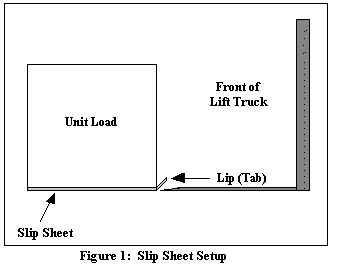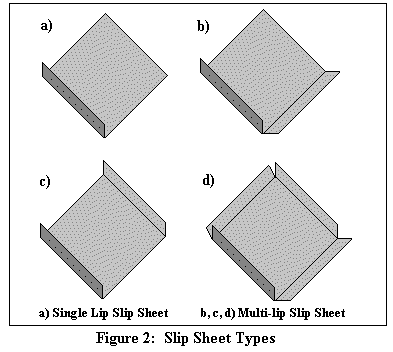DESCRIPTION:
The slip sheet is used as a unit load support device in vehicle delivery and transportation of products. When slip sheets are supported by a pallet board, roller conveyor surface, flat load carrying surface, or a cart or lift truck, the structural strength of the slip sheet supports the product loads weight [1]. With the slip sheet supported by one of these transportation devices the unit load can easily be transported both internally within a facility and externally between two facility locations [1]. The basic setup for lifting the slip sheet unit load is seen below (Fig. 1).

SLIP SHEET TYPES:
There are several types of slip sheets that can be used for the transportation of a unit load depending upon the desired use of the sheet. The slip sheet is shaped and dimensioned to the size of the product or unit load [1]. The type of slip sheet varies depending on both the number of lip extensions and the material from which it is manufactured (Fig. 2)[1].
The variation used would depend on the loading patterns, unit load parameters, and desired maneuverability of the slip sheet/unit load [1]. Normally, the thickness of the slip sheet is <1/2 in. [1].
For most warehouses, plant functional material handling equipment, and the travel-path clearances, this fraction of an inch height increase does not stage a problem [1]. When designing an in-house transportation path for the slip sheet unit load, the slip sheet has a 4 to 6 in. lip (tab) that extends beyond one or more of the sides of the slip sheet [1]. The lip extensions permit a push-pull device to lift the slip sheet unit load [1].
Single Lip Slip Sheet: The first type of slip sheet is the single lip (tab) slip sheet (Fig.2).

With a single lip, the lip faces the narrow part of the rectangular shaped unit load and the delivery truck door [1]. This slip sheet variation maximizes the delivery truck’s space utilization and loading and unloading process productivity [1]. Also, with a single lip, the travel path clearance is minimized as the lip facing the unit load carrier.
Multi-lip Slip Sheet: The second type of slip sheet is the multi-lip slip sheet (Fig. 2). This type of slip sheet is generally used on a container placed onto a rail car or an ocean delivery vehicle due to the necessary loading/unloading patterns [1]. This allows a loading device to load the slip sheet unit load from one side and an unloading device to unload the load from another side depending on the number and pattern of the remaining lips.
LIP HANDLING OPTIONS:
During the transportation or your slip sheet, there are several options for handling the slip sheet’s lip [1].
SLIP SHEET MATERIALS:
Corrugated Slip Sheet Material: The corrugated material consists of two kraft liner board outer surfaces with a corrugated interior that is bonded together with adhesive or glue [1]. This bonded material provides the necessary strength for the push-pull device to clamp the slip sheet once or twice [1]. There are several disadvantages associated with this type of slip sheet material including that it is not very durable, moisture resistant, resistant to high humidity or usable in cold storage areas [1]. The advantages associated with this material are low cost, one-way use, and its ability to be moved by a conveyor or lift truck with a slip sheet device [1].
Fiberboard or Solid Kraftboard Slip Sheet Material: The fiberboard slip sheet consists of several layers of solid fiberboard sheets laminated together [1]. The bonding of layers of several flat solid kraftboard sheets increases the slip sheet’s non-tear strength [1]. This, in return, allows the slip sheet to be used several times and in different temperatures [1]. In addition, some fiberboard slip sheets are coated with a plastic coating to improve its use in humid environments [1]. The disadvantages to this type of slip sheet are that it has a medium cost and is not very durable [1]. The advantages with this material are its multiple uses, ability to withstand humid and cold environments, and ability to be handled by conveyors, AGV, or other power unit load transportation devices [1].
Plastic Slip Sheet Material: The plastic slip sheet is made of a combination of polyethylene materials [1]. This type of material allows for greater non-tear strength and an increased number of uses in cold and humid environments [1]. The only disadvantage to the plastic slip sheet is the high cost [1]. Yet, its advantages include longer sheet life, durable lips, ability to be stored in cold or humid environments, and can be handled by a roller conveyor, slip sheet lift truck, AGV, or powered unit load transportation devices [1].
SLIP SHEET vs. PALLET:
When considering the use of a slip sheet vs. a pallet, there are several advantages and disadvantages associated with both.
Slip Sheet Advantages:
Slip Sheet Disadvantages:
Overall, the advantages of slip sheets vs. pallets highly overate the disadvantages associated with the two.
SLIP SHEET DESIGN CONCIDERATIONS: (Ref. [1])
CASE STUDYS:
“By converting some of its vendors from shipping on wooden pallets to shipping on plastic slip sheets, Home Depot figures it has eliminated 1.8 million pallets from its retail operations and reduced costs by $660,000. Slip sheets (1) cost less than pallets; (2) weigh much less, saving transport charges; and (3) are only a fraction the thickness of pallets, thus increasing cube and improving the efficiency of truck loading. On the receiving end, slip sheets can be reused, typically 8 to 10 times. Home Depot reuses slip sheets arriving at its distribution centers to send products to its stores. When the pull tabs rip and a slip sheet can no longer be used, it is sent to a plastics processor for grinding, melting, and remanufacturing.”[4]
“Eliminate wood pallet problems (initial high cost of purchase, storage space, damage to your product due to protruding nails, and costly nuisance of disposal of damage wood pallets). Utilize cost-efficient plastic slip sheets and all of the above problems are gone! In the past year we have successfully transferred from wood/or fiber to polyethylene slip sheets such companies as Hewlett-Packard, Eagle Snacks, Clorox, Hills Pet Nutrition and J.R. Simplot (french fry mfg. for McDonald's). Plastic Slip sheets are competitive right now ---the future will only increase their value.” (Mcnamee & Associates [5])
REFERENCES:
| Top | MHE Taxonomy Home |
Last modified: September 30, 1999 |
Created by: N. Shane Sebastian (NCSU, IE753, Fall 1999) |